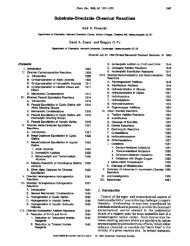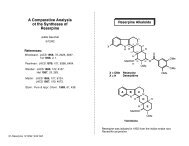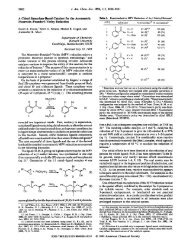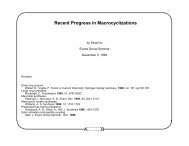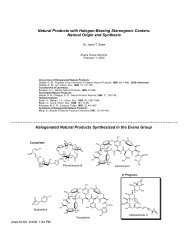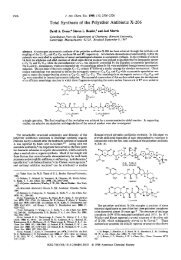Surface Plasmon Resonance Enhanced Magneto-Optics ...
Surface Plasmon Resonance Enhanced Magneto-Optics ...
Surface Plasmon Resonance Enhanced Magneto-Optics ...
Create successful ePaper yourself
Turn your PDF publications into a flip-book with our unique Google optimized e-Paper software.
Letter<br />
Subscriber access provided by HARVARD UNIV<br />
<strong>Surface</strong> <strong>Plasmon</strong> <strong>Resonance</strong> <strong>Enhanced</strong> <strong>Magneto</strong>-<strong>Optics</strong> (SuPREMO):<br />
Faraday Rotation Enhancement in Gold-Coated Iron Oxide Nanocrystals<br />
Prashant K. Jain, Yanhong Xiao, Ronald Walsworth, and Adam E. Cohen<br />
More About This Article<br />
Nano Lett., Article ASAP • DOI: 10.1021/nl900007k • Publication Date (Web): 13 March 2009<br />
Downloaded from http://pubs.acs.org on March 14, 2009<br />
Additional resources and features associated with this article are available within the HTML version:<br />
• Supporting Information<br />
• Access to high resolution figures<br />
• Links to articles and content related to this article<br />
• Copyright permission to reproduce figures and/or text from this article<br />
Nano Letters is published by the American Chemical Society. 1155 Sixteenth<br />
Street N.W., Washington, DC 20036
<strong>Surface</strong> <strong>Plasmon</strong> <strong>Resonance</strong> <strong>Enhanced</strong><br />
<strong>Magneto</strong>-<strong>Optics</strong> (SuPREMO): Faraday<br />
Rotation Enhancement in Gold-Coated<br />
Iron Oxide Nanocrystals<br />
Prashant K. Jain, † Yanhong Xiao, ‡ Ronald Walsworth, ‡,§ and Adam E. Cohen* ,†,§<br />
Department of Chemistry and Chemical Biology, Department of Physics, HarVard<br />
UniVersity, Cambridge, Massachusetts, 02138, and HarVard-Smithsonian Center for<br />
Astrophysics, Cambridge, Massachusetts, 02138<br />
Received January 1, 2009; Revised Manuscript Received March 2, 2009<br />
ABSTRACT<br />
We report enhanced optical Faraday rotation in gold-coated maghemite (γ-Fe2O3) nanoparticles. The Faraday rotation spectrum measured<br />
from 480-690 nm shows a peak at about 530 nm, not present in either uncoated maghemite nanoparticles or solid gold nanoparticles. This<br />
peak corresponds to an intrinsic electronic transition in the maghemite nanoparticles and is consistent with a near-field enhancement of<br />
Faraday rotation resulting from the spectral overlap of the surface plasmon resonance in the gold with the electronic transition in maghemite.<br />
This demonstration of surface plasmon resonance-enhanced magneto-optics (SuPREMO) in a composite magnetic/plasmonic nanosystem<br />
may enable design of nanostructures for remote sensing and imaging of magnetic fields and for miniaturized magneto-optical devices.<br />
Nanostructures of noble metals, especially gold (Au), silver<br />
(Ag), and copper (Cu), are interesting from both fundamental<br />
and technological standpoints due to their localized surface<br />
plasmon resonance, which is the collective oscillation of the<br />
conduction electrons when excited with visible light. 1,2<br />
<strong>Plasmon</strong> resonances impart these nanostructures with unusual<br />
optical properties, such as strongly enhanced size-, shape-,<br />
and medium-dependent light absorption and Mie scattering.<br />
2-5 Localized surface plasmons have been employed in<br />
a wide range of applications 6 including imaging, 7,8 chemical<br />
and biological sensing and probing, 9-11 and targeted photothermal<br />
therapy. 8,12,13 In addition to these far-field optical<br />
attributes, excitation of localized surface plasmon resonances<br />
results in strong confinement of electric fields around the<br />
nanostructure, 14-16 causing near-field enhancements of linear<br />
and nonlinear optical processes. 17,18 A prime example of such<br />
electromagnetic field enhancement is the amplification of<br />
Raman scattering by 10 5 -10 6 for molecules adsorbed on gold<br />
or silver nanoparticles 19 (and up to 10 14 -10 15 at “hot spots”<br />
at the intersection of two or more nanoparticles 20,21 ). In recent<br />
years, plasmonic enhancement of photoluminescence from<br />
fluorophores, 22-24 infrared vibrational absorption, 17 second<br />
* Towhomcorrespondenceshouldbeaddressed.E-mail:cohen@chemistry.<br />
harvard.edu.<br />
† Department of Chemistry and Chemical Biology, Harvard University.<br />
‡ Harvard-Smithsonian Center for Astrophysics.<br />
§ Department of Physics, Harvard University.<br />
10.1021/nl900007k CCC: $40.75 © XXXX American Chemical Society<br />
NANO<br />
LETTERS<br />
XXXX<br />
Vol. xx, No. x<br />
-<br />
harmonic processes, 25-27 and photochemistry28 have also been<br />
demonstrated using metal nanostructures.<br />
The rotation of the polarization of light in a magnetized<br />
medium can be observed either in reflection (Kerr rotation)<br />
or in transmission (Faraday rotation). 29 <strong>Magneto</strong>-optical<br />
(MO) phenomena provide physical information on electronic<br />
and spin structure of materials30-32 and have also found<br />
applications in magnetic field sensors, optical isolators, data<br />
storage, and fast optical modulation. 29 Here, we demonstrate<br />
a new surface plasmon enhanced MO effect, which we call<br />
“SuPREMO”, in the form of enhanced optical Faraday<br />
rotation in a composite nanostructure consisting of magnetic<br />
maghemite nanoparticles coated with a plasmonic gold shell.<br />
MO effects in most media are typically small. One<br />
approach for enhancing MO effects is the integration of MOactive<br />
media with photonic crystals, leading to enhanced<br />
Faraday rotation at the photonic band gap edge. 33,34 Another<br />
theoretical proposal involves the use of metal films with<br />
arrays of subwavelength holes filled with an MO-active<br />
material. 35,36 These structures support electromagnetic modes<br />
displaying extraordinary optical transmission (EOT) along<br />
with high Faraday rotation.<br />
There has been recent interest in employing optical<br />
resonances of noble metal nanostructures for enhancing MO<br />
phenomena. 37-45 Hui and Stroud proposed on theoretical<br />
grounds that media containing noble metal nanoparticles<br />
should show enhanced Faraday rotation at optical frequencies
corresponding to the localized surface plasmon resonance. 40<br />
Early studies on Fe/Cu bilayer films showed an enhanced<br />
Kerr rotation response in the spectral region corresponding<br />
to the metal bulk plasmon edge. 46,47 Multilayered ferromagnetic/noble<br />
metal structures, 48-50 especially the Au/Co/Au<br />
system, 37 have been observed to exhibit Kerr rotation<br />
enhancement due to the thin-film surface plasmon resonance<br />
of the noble metal. Recent experiments have shown that<br />
magnetic films integrated with gold nanoparticles show<br />
enhanced Kerr rotation at the localized surface plasmon<br />
resonance of the gold nanoparticles. 37-39<br />
One can classify enhancement in composite magnetic/<br />
plasmonic systems into two categories, depending on the<br />
relative positions of plasmonic and MO resonances and the<br />
measurement wavelength. When the plasmon resonance is<br />
far from any MO resonances, the MO enhancement is<br />
expected to occur with the same spectral dependence as the<br />
plasmon resonance. 37-39 When there is good overlap between<br />
the plasmonic and the MO resonances, a plasmon resonance<br />
can cause an enhancement in a MO resonance of the nearby<br />
nonplasmonic magnetic medium. The MO enhancement in<br />
this case reflects the spectrum of electronic transitions of<br />
the nonplasmonic magnetic medium. The studies mentioned<br />
above demonstrate the first type of enhancement, but there<br />
has not been a clear demonstration of the latter form of<br />
enhancement arising from the overlap of a plasmonic and a<br />
MO resonance. A recent paper by Tomita et al. suggested<br />
such an enhancement in the Kerr rotation in a yttrium-iron<br />
garnet thin film incorporated with gold nanoparticles, but<br />
the effect was not well resolved. 42 Li et al. studied the<br />
Faraday rotation of pairs of CoFe2O4 and Ag nanoparticles<br />
at a few discrete wavelengths and found differences from<br />
the Faraday rotation of CoFe2O4 nanoparticles, but the lack<br />
of full spectra leaves the interpretation of the nature of the<br />
plasmonic effect ambiguous. 45 The SuPREMO effect demonstrated<br />
here is the first example of a nanostructure<br />
composite of a magneto-optically active material and a<br />
plasmonic metal showing plasmon-enhanced MO effects. As<br />
described below, we observe enhanced visible-region Faraday<br />
rotation for gold-coated maghemite (γ-Fe2O3) nanoparticles<br />
at wavelengths ∼530 nm, where there is spectral overlap of<br />
the surface plasmon resonance in gold with an intrinsic<br />
electronic transition in maghemite. In contrast, we observe<br />
no enhanced Faraday rotation for either uncoated maghemite<br />
nanoparticles or solid gold nanoparticles. These observations<br />
are consistent with localized surface plasmons excited in the<br />
nanostructure enhancing the MO effect of the electronic<br />
transition in γ-Fe2O3 nanoparticles.<br />
Composite magnetic/plasmonic nanostructures were fabricated<br />
using a colloidal method. 51 First, Fe3O4 (magnetite)<br />
nanoparticles were synthesized by the coprecipitation of<br />
Fe(II) and Fe(III) chlorides with NaOH as the reducing agent.<br />
A 25 mL solution containing 10 mmol FeCl2·4H2O and 20<br />
mmol FeCl3·6H2O with 10 mmol HCl was added dropwise<br />
to a 250 mL solution of 1.5 M NaOH under vigorous stirring,<br />
resulting in the formation of a black precipitate (Fe3O4<br />
nanoparticles). The precipitate was washed with Nanopure<br />
water followed by washing with 0.1 M HNO3 solution and<br />
centrifugation at 6000 rpm for 20 min. The precipitate was<br />
redispersed in 0.03 M HNO3 solution and heated in a water<br />
bath at 90-100 °C for at least 30 min., resulting in the<br />
complete oxidation of the Fe3O4 colloid to the reddish brown<br />
γ-Fe2O3 (maghemite) colloid. The γ-Fe2O3 colloid was<br />
centrifuged at 6000 rpm for 20 min and the precipitate was<br />
washed first with water and then with 0.1 M tetramethyl<br />
ammonium hydroxide (TMAOH) solution, followed by an<br />
additional centrifugation step at 6000 rpm for 20 min. The<br />
nanoparticles were redispersed in 0.1 M TMAOH solution.<br />
The hydroxide ions from TMAOH adsorb to the surface of<br />
the iron oxide nanoparticles forming a passivating doublelayer.<br />
X-ray diffraction (XRD) measurements on a dried<br />
sample of the colloid confirmed the synthesis of γ-Fe2O3<br />
(Scintag XDS 2000 diffractometer, copper-K radiation<br />
1.5406 Å). The XRD pattern (Figure 1a) shows peaks<br />
corresponding to known lattice planes in maghemite. The<br />
lattice parameter estimated from the diffraction peaks (8.34<br />
+ 0.02 Å) agrees well with the literature value for<br />
maghemite. 52<br />
Next, the maghemite nanoparticles were coated with gold<br />
by the iterative seeding method described previously. 51<br />
Typically 80 mL of a γ-Fe2O3 colloid solution (∼0.05 mM<br />
in γ-Fe2O3 units) was stirred vigorously with 5 mM sodium<br />
citrate for at least 10 min to replace the surface hydroxide<br />
ions with citrate ions, which serve as a stabilizing agent for<br />
the gold coating. To this solution, HAuCl4 solution (1% by<br />
Au weight) was added followed by an equal volume of 0.2<br />
M hydroxylamine hydrochloride (NH2OH·HCl). Four iterations<br />
of these additions were performed with at least 10 min<br />
between subsequent additions. The hydroxylamine hydrochloride<br />
reduces the Au3+ to Au, but does so preferentially<br />
on the surface of the citrate-capped γ-Fe2O3 nanoparticles. 53<br />
The gold nuclei initially formed on the γ-Fe2O3 surface act<br />
as seeds for further Au3+ reduction in subsequent iterations.<br />
The formation of the gold coating on the γ-Fe2O3 was<br />
characterized by following the UV-visible extinction spectra<br />
on an Ocean <strong>Optics</strong> USB 4000 spectrometer (150 ms<br />
integration time, 100 averages, and boxcar width of 2). As<br />
shown in Figure 2, the extinction spectrum of the unmodified<br />
γ-Fe2O3 nanoparticles does not show any strong absorption<br />
in the visible region. Following the first deposition of gold,<br />
a visible absorption band develops at around 614 nm, which<br />
can be attributed to the localized surface plasmon resonance<br />
of the gold-coated nanostructure. It is well established that<br />
a nanostructure consisting of a gold shell around a dielectric<br />
core shows a plasmon resonance significantly red-shifted<br />
compared to the plasmon resonance of a solid gold nanosphere,<br />
which is known to be around 520 nm. 54,55 This red<br />
shift is due to the electromagnetic coupling between the<br />
plasmon oscillations on the inner and the outer surfaces of<br />
the gold shell. With further addition of gold, we found that<br />
the plasmon resonance band shifts toward the blue and<br />
becomes narrower, consistent with an increase in the<br />
thickness of the gold coating. Other factors, such as a change<br />
to a more spherical shape and filling of the initial hollow<br />
shell may also contribute. 51 The plasmon band did not blue<br />
shift much after the fifth iteration of gold addition. Thus,<br />
B Nano Lett., Vol. xx, No. x, XXXX
Figure 1. (a) Powder XRD pattern for γ-Fe2O3 nanoparticles. The<br />
red curve is a 50-point median averaging of the data. Five diffraction<br />
peaks have been assigned based on literature and used to calculate<br />
a lattice parameter of 8.34 + 0.02 Å. Representative transmission<br />
electron microscopy images of (b) bare γ-Fe2O3 nanoparticles and<br />
(c) gold-coated γ-Fe2O3 nanoparticles following magnetic separation<br />
and purification steps.<br />
Figure 2. UV-visible absorbance spectra of gold-coated γ-Fe2O3<br />
nanoparticles shown as a function of the molar ratio of the<br />
maghemite nanoparticles (in Fe2O3 units) to Au ions added during<br />
the iterative gold-coating process. The spectrum for bare γ-Fe2O3<br />
nanoparticles is shown in black. The black arrow indicates the<br />
shoulder absorption corresponding to an electronic transition in<br />
γ-Fe2O3.<br />
we selected the fifth-iteration gold-coated γ-Fe2O3 nanoparticles<br />
for further characterization. The nanoparticles were<br />
subjected to separation on a strong neodymium magnet to<br />
isolate them from any purely gold particles that may have<br />
nucleated. The magnetically separated precipitate was then<br />
centrifuged at a low speed (800 rpm) for 20 min to remove<br />
any γ-Fe2O3 nanoparticles that may have remained uncoated.<br />
The latter purification steps are important to ensure that the<br />
samples consist predominantly of the composite plasmonic/<br />
magnetic nanostructures. Following the purification steps,<br />
the gold-coated γ-Fe2O3 nanoparticles showed a plasmon<br />
resonance band maximum at about 560 nm.<br />
Transmission electron microscopy (TEM) images of both<br />
uncoated γ-Fe2O3 nanoparticles and the purified gold-coated<br />
nanoparticles (shown respectively in Figure 1b,c) were taken<br />
on a JEOL 2100 TEM operating at 200 kV. TEM samples<br />
were prepared by drop-casting 2 µL of the sonicated colloidal<br />
solution on a carbon-coated Formvar-supported 100 mesh<br />
copper grid and drying the solution in air. From a representative<br />
TEM image (Figure 1b), the uncoated γ-Fe2O3 nanoparticles<br />
showed an average diameter of 5.1 nm (with a 1.5<br />
nm standard deviation). At this size, γ-Fe2O3 nanoparticles<br />
are superparamagnetic. 52 The gold coating resulted in nanoparticles<br />
with an average diameter of 54.7 nm (with a<br />
standard deviation of 18.5 nm), and much higher electron<br />
microscopy contrast due to the gold.<br />
Faraday rotation measurements of Fe3O4, γ-Fe2O3, pure<br />
gold, and gold-coated γ-Fe2O3 nanoparticles were performed<br />
in the visible spectral range. The optical setup (shown in<br />
Scheme 1) consisted of a supercontinuum fiber laser (Fianium,<br />
Inc.) with an acousto-optic tunable filter (Crystal<br />
Technology, Inc.), which allowed the tuning of the illumination<br />
wavelength λ from 480 to 690 nm. The laser beam was<br />
linearly polarized by passing through a Glan Thompson<br />
polarizer (extinction ratio 10 5 ) and then transmitted through<br />
the sample solution in a1cmpath length optical cell placed<br />
in the core of a homemade electromagnet. The electromagnet<br />
was driven by a high-current amplifier at 900 Hz, generating<br />
a peak magnetic field of 150 Gauss. The beam transmitted<br />
Nano Lett., Vol. xx, No. x, XXXX C
Scheme 1. Experimental Setup for Faraday Rotation<br />
Measurement<br />
through the sample was then passed through a visible-range<br />
polarizing beamsplitter, which splits the beam of intensity I<br />
into a transmitted beam of intensity It and a reflected beam<br />
of intensity Ir. For a small clockwise Faraday rotation θ, we<br />
have<br />
It ) I<br />
(1 + cos 2� + 2θ sin 2�) (1)<br />
2<br />
Ir ) I<br />
(1 - cos 2� - 2θ sin 2�) (2)<br />
2<br />
where � is the angle between the input polarization from<br />
the laser and the horizontal axis of the polarizing beamsplitter.<br />
An autobalanced photodetector (New Focus Nirvana<br />
2007) was employed to measure It and Ir. For proper function<br />
of the autobalancing circuit, � was set to 54.7°, yielding Ir<br />
≈ 2It. The Faraday rotation angle θ was extracted by software<br />
lock-in at the magnetic field modulation frequency (900 Hz)<br />
and measured as a function of wavelength from 480 to 690<br />
nm in 5 nm increments. Spectra were generated by typically<br />
averaging 10 such wavelength scans. Using this setup, we<br />
measured the Verdet constant of water to be 3.79 ( 0.01 ×<br />
10 -6 rad/G·cm at 590 nm within
crosses zero at 580 nm and displays a relatively small<br />
positive Faraday rotation at longer wavelengths.<br />
The comparatively large Faraday rotation of Fe3O4 nanoparticles<br />
as wavelengths approach the near-infrared is due<br />
to intervalence charge-transfer transitions (0.6 eV) between<br />
neighboring Fe 3+ and Fe 2+ ions in Fe3O4, 61 which is a<br />
semimetal. 62 γ-Fe2O3, on the other hand, has an optical<br />
absorption edge around 2 eV with only weak absorption in<br />
the near-infrared region. 61,62 We note that the difference in<br />
the Faraday rotation spectra of Fe3O4 and γ-Fe2O3 nanoparticles<br />
could be used to quantitatively follow changes in the<br />
oxidation state of iron oxide. This information is typically<br />
accessible only by more sophisticated techniques such as<br />
X-ray absorption near-edge structure (XANES). 62,63 In<br />
particular, we measured the ratio of Faraday rotation at 630<br />
nm to that at 530 nm to be -0.34 for the γ-Fe2O3<br />
nanoparticles, compared to -2.63 for the Fe3O4 nanoparticles.<br />
The Faraday rotation spectra of uncoated and gold-coated<br />
γ-Fe2O3 nanoparticles are compared in Figure 3b. The goldcoated<br />
γ-Fe2O3 nanoparticles show an overall similar Faraday<br />
rotation spectrum to the uncoated particles, with the exception<br />
of a sharp peak that appears around 530 nm. The<br />
uncoated γ-Fe2O3 nanoparticles show only a weak shoulder<br />
in this region; no well-resolved resonant feature can be<br />
discerned. A simple “non-interacting” mixture of γ-Fe2O3<br />
nanoparticles and colloidal gold nanospheres (green curve<br />
in Figure 3b) with an absorbance matched to that of the goldcoated<br />
γ-Fe2O3 nanoparticle sample also does not show the<br />
sharp Faraday rotation peak at 530 nm. This demonstrates<br />
that the rotation peak is not due merely to the presence of<br />
the gold component, but rather is a consequence of the close<br />
proximity of the gold and the γ-Fe2O3 in the composite<br />
γ-Fe2O3 /gold nanostructure.<br />
The Faraday rotation peak, observed at 530 nm for goldcoated<br />
γ-Fe2O3 nanoparticles, is blue shifted and much<br />
narrower compared to the gold plasmon absorption band,<br />
establishing that this enhanced Faraday rotation is not simply<br />
due to Faraday rotation associated with the plasmon resonance.<br />
38,39 As detailed below, we propose that localized<br />
surface plasmons excited in the nanostructure enhance the<br />
strength of a Faraday rotation band that is intrinsic to the<br />
γ-Fe2O3, but that is normally too weak to resolve.<br />
On the basis of an estimated concentration of ∼1.7 mM<br />
(in γ-Fe2O3 units) of the γ-Fe2O3 nanoparticles, we deduce<br />
a Faraday rotation at 480 nm of -2.4° T -1 for a ∼1 µm<br />
path length of γ-Fe2O3 nanoparticles. The particle concentration<br />
for the gold-coated iron oxide nanoparticles is not known<br />
and therefore the rotation enhancement due to the addition<br />
of the gold shell cannot be directly estimated on a per-particle<br />
basis. However, by making a very rough approximation that<br />
the Faraday rotation at 480 nm is not affected by the plasmon<br />
resonance, we calculate an enhancement from the ratio of<br />
the rotation at 530 nm (normalized to the rotation at 480<br />
nm) for the gold-coated particles to that of the uncoated<br />
particles. The enhancement factor estimated in this way is<br />
1.75. The remarkable feature of the enhancement is the<br />
appearance of a sharp and previously indiscernible Faraday<br />
rotation peak, rather than the numerical value of the<br />
enhancement over background.<br />
The origin of the Faraday rotation peak at 530 nm can be<br />
traced to the electronic structure of the γ-Fe2O3, specifically<br />
the crystal field transitions of Fe3+ 3d5 electrons that dominate<br />
the visible spectrum of iron oxides. 59,60 The crystal field<br />
transitions of the Fe3+ 3d electrons are in principle both spinand<br />
parity-forbidden. 60 However, in ferrimagnets such as<br />
γ-Fe2O3, these transitions become weakly allowed32,60 due<br />
to the magnetic exchange coupling between Fe3+ centers<br />
(next-nearest neighbors) on antiparallel sublattices. Hence<br />
these transitions make a small contribution to the electronic<br />
absorption and magneto-optical activity.<br />
γ-Fe2O3 has a weakly dipole-allowed electronic absorption<br />
in the 480-550 nm region, assigned by Sherman et al. to a<br />
“spin-flip” electron pair transition (EPT). 60,64 The EPT<br />
involves the simultaneous excitation of two Fe3+ centers on<br />
neighboring antiparallel sublattices from their ground ( 6A1) state to the first excited ( 4T1) state, without a net change in<br />
spin. 60 In agreement with previous studies, the bare γ-Fe2O3<br />
nanoparticles in the present study show a weak shoulder in<br />
the UV-vis absorption spectrum indicated by the black<br />
arrow in Figure 2. The band edge of this absorption band is<br />
obtained from a photoluminescence spectrum (Figure 4) of<br />
the γ-Fe2O3 nanoparticles (Varian Cary Eclipse spectrofluorimeter<br />
with a xenon lamp excitation source and 10 nm<br />
excitation and emission slits). Under 475 nm excitation, the<br />
γ-Fe2O3 nanoparticles show weak photoluminescence with<br />
a peak at 530 nm, corresponding to the band-edge emission<br />
of an electronic transition in γ-Fe2O3. A previous study on<br />
γ-Fe2O3 nanoparticles found a similar band edge and<br />
excitonic photoluminescence band around 520 nm. 65 The<br />
EPT, cited to be around 510 nm in γ-Fe2O3, is therefore the<br />
most likely assignment of this transition. 60 It is conceivable<br />
that the transition in the nanocrystals of γ-Fe2O3 is somewhat<br />
red shifted relative to the bulk due to surface effects. 66<br />
The weak absorption corresponding to the EPT in γ-Fe2O3<br />
implies a weak oscillator strength for this transition relative<br />
to the stronger electronic absorption transitions of γ-Fe2O3<br />
at the UV end of the spectrum. Pershan and co-workers<br />
previously pointed out that the strength of dipole-forbidden<br />
crystal field transitions can be enhanced when electric-dipole<br />
transitions that can be ad-mixed to relieve the parity<br />
constraint lie close by in energy. 42,67 The excitation of<br />
localized surface plasmons in our nanostructure provides<br />
strong dipoles spectrally and spatially close to the EPT. These<br />
plasmon resonances could lead to an increase in the transition<br />
strength of the EPT, allowing this transition to contribute to<br />
the magneto-optical response. Tomita et al. recently suggested<br />
the enhancement via strong near-field excitation of<br />
dipole-forbidden crystal field transitions in yttrium-iron<br />
garnet (YIG) thin films incorporating gold nanoparticles, to<br />
explain observed anomalies in the measured Kerr rotation<br />
spectrum in the region of the localized surface plasmon<br />
resonance. 42 In combination with the enhancement of the EPT<br />
via intense electric fields, the likely presence of strong field<br />
gradients in the plasmonic field can relieve the parity<br />
constraint on these transitions.<br />
Nano Lett., Vol. xx, No. x, XXXX E
In an equivalent picture, the composite magnetic/plasmonic<br />
nanostructure can be visualized to be a magnetic particle<br />
embedded in a resonant optical cavity. Because of the large<br />
density of photon states in the cavity, the interaction between<br />
the electromagnetic field of the light and the electronic<br />
transitions of the magnetic material is enhanced, resulting<br />
in a large Faraday rotation in this spectral region.<br />
The magnitude of the magneto-optical enhancement is<br />
governed primarily by the spectral overlap of the magnetooptical<br />
transition and the plasmon resonance. The EPT is<br />
spectrally close to the plasmon resonance band at ∼560 nm<br />
and is therefore enhanced and manifested as a well-resolved<br />
peak in the Faraday rotation spectrum. Another factor that<br />
contributes to the magnitude of the enhancement is the<br />
quality (energy/line-width) of the plasmon resonance mode.<br />
Narrow intense resonances are expected to provide the<br />
strongest enhancement. We observed significant Faraday<br />
rotation enhancement only from the nanoparticle sample<br />
(from Figure 2) with the most blue-shifted and narrow<br />
plasmon resonance.<br />
In summary, we observed enhanced optical Faraday<br />
rotation, peaking at about 530 nm, in a composite plasmonic/<br />
magnetic nanostructure, consisting of gold-coated γ-Fe2O3<br />
(maghemite) nanoparticles, whereas enhanced Faraday rotation<br />
was not observed in either uncoated γ-Fe2O3 nanoparticles<br />
or solid gold nanoparticles. The 530 nm Faraday<br />
rotation peak corresponds to an intrinsic electronic transition<br />
in the maghemite nanoparticles consistent with a surface<br />
plasmon resonance-enhanced magneto-optical (SuPREMO)<br />
effect. A more detailed theoretical understanding of the<br />
SuPREMO effect will be pursued in future work. Relevant<br />
parameters may include the following: magneto-optically<br />
active electronic transition matrix elements and their sensitivity<br />
to applied magnetic field; spectral and spatial overlap of<br />
the localized surface plasmon resonance with electronic<br />
transitions; and coupling between the plasmon resonance and<br />
magneto-optically active transitions. For future applications<br />
of the SuPREMO effect, it is advantageous that the spectrum<br />
of localized surface plasmon modes can be tuned by varying<br />
either the geometry or the choice of the plasmonic metal<br />
(e.g., gold, silver, copper). 2,3,5,6,54 Colloidal techniques 3,5,68<br />
as well as nanolithography methods 69-71 are well developed<br />
to achieve such tunability. Composite plasmonic/magnetic<br />
nanostructures are therefore a promising modality for<br />
enhanced and tailored optical polarization rotation, extended<br />
spectral range, and nanosized dimension. Such materials are<br />
desired in various applications including optical data storage,<br />
design of miniaturized magneto-optic devices, and optical<br />
sensing and imaging of magnetic fields and magnetic domain<br />
structures. 29,72 An avenue for future research is to explore<br />
SuPREMO effects in other magneto-optical electronic transitions,<br />
including other ferrites 30 or Fe-containing garnets. 29,58<br />
Acknowledgment. This work was supported partially by<br />
Siemans Healthcare and the Materials Research Science and<br />
Engineering Center of the National Science Foundation under<br />
NSF Award Number DMR-02-13805. We acknowledge the<br />
use of TEM facilities at the Center for Nanoscale Systems<br />
(CNS), a part of the Faculty of Arts and Sciences at Harvard<br />
University and a member of the National Nanotechnology<br />
Infrastructure Network (NNIN), which is supported by the<br />
National Science Foundation under award no. ECS-0335765.<br />
We thank Dr. William Croft for XRD training and Dr.<br />
Darrick Chang for helpful discussions.<br />
References<br />
(1) Bohren, C. F.; Huffman, D. R. Absorption and Scattering of Light by<br />
Small Particles; Wiley: New York, 1983.<br />
(2) Kelly, K. L.; Coronado, E.; Zhao, L. L.; Schatz, G. C. J. Phys. Chem.<br />
B 2003, 107, 668–677.<br />
(3) Halas, N. J. MRS Bull. 2005, 30, 362–367.<br />
(4) Mie, G. Ann. Phys. 1908, 25, 377–445.<br />
(5) Link, S.; El-Sayed, M. A. Int. ReV. Phys. Chem. 2000, 19, 409–453.<br />
(6) Jain, P. K.; Huang, X.; El-Sayed, I. H.; El-Sayed, M. A. Acc. Chem.<br />
Res. 2008, 41, 1578–1586.<br />
(7) El-Sayed, I. H.; Huang, X.; El-Sayed, M. A. Nano Lett. 2005, 5, 829–<br />
834.<br />
(8) Loo, C., A.; Lowery, A.; Halas, N.; West, J.; Drezek, R. Nano Lett.<br />
2005, 5, 709–711.<br />
(9) Haes, A. J.; Van Duyne, R. P. J. Am. Chem. Soc. 2002, 124, 10596–<br />
10604.<br />
(10) Elghanian, R.; Storhoff, J. J.; Mucic, R. C.; Letsinger, R. L.; Mirkin,<br />
C. A. Science 1997, 277, 1078–1080.<br />
(11) Sonnichsen, C.; Reinhard, B. M.; Liphardt, J.; Alivisatos, A. P. Nat.<br />
Biotechnol. 2005, 23, 741–745.<br />
(12) Hirsch, L. R.; Stafford, R. J.; Bankson, J. A.; Sershen, S. R.; Rivera,<br />
B.; Price, R. E.; Hazle, J. D.; Halas, N. J.; West, J. L. Proc. Natl.<br />
Acad. Sci. U.S.A. 2003, 100, 13549–13554.<br />
(13) Huang, X.; El-Sayed, I. H.; Qian, W.; El-Sayed, M. A. J. Am. Chem.<br />
Soc. 2006, 128, 2115–2120.<br />
(14) Hao, E.; Schatz, G. C. J. Chem. Phys. 2004, 120, 357–366.<br />
(15) Sweatlock, L. A.; Maier, S. A.; Atwater, H. A.; Penninkhof, J. J.;<br />
Polman, A. Phys. ReV. B2005, 71, 235408.<br />
(16) Schuck, P. J.; Fromm, D. P.; E., W.; Sundaramurthy, A.; Kino, G.<br />
Phys. ReV. Lett. 2005, 94, 017402.<br />
(17) Anderson, M. S. Appl. Phys. Lett. 2008, 92, 123101–123103.<br />
(18) Schatz, G. C.; Van Duyne, R. P. Electromagnetic Mechanism of<br />
<strong>Surface</strong>-enhanced Spectroscopy. In Handbook of Vibrational Spectroscopy;<br />
Chalmers, J. M., Griffiths, P. R., Eds.; Wiley: New York,<br />
2002; pp 759-774.<br />
(19) Schatz, G. C. Acc. Chem. Res. 1984, 17, 370–376.<br />
(20) Nie, S.; Emory, S. R. Science 1997, 275, 1102–1106.<br />
(21) Jiang, J.; Bosnick, K.; Maillard, M.; Brus, L. J. Phys. Chem. B 2003,<br />
107, 9964–9972.<br />
(22) Aslan, K.; Lakowicz, J. R.; Szmacinski, H.; Geddes, C. D. J. Fluoresc.<br />
2004, 14, 677–679.<br />
(23) Boyd, G. T.; Yu, Z. H.; Shen, Y. R. Phys. ReV. B1986, 33, 7923–<br />
7936.<br />
(24) Tam, F.; Goodrich, G. P.; Johnson, B. R.; Halas, N. J. Nano Lett.<br />
2007, 7, 496–501.<br />
(25) Stockman, M. I.; Bergman, D. J.; Anceau, C.; Brasselet, S.; Zyss, J.<br />
Phys. ReV. Lett. 2004, 92, 057402.<br />
(26) Chen, K.; Durak, C.; Heflin, J. R.; Robinson, H. D. Nano Lett. 2007,<br />
7, 254–258.<br />
(27) Kim, S.; Jin, J.; Kim, Y.; Park, I.; Kim, Y.; Kim, S. Nature 2008,<br />
453, 757–760.<br />
(28) Sundaramurthy, A.; Schuck, P. J.; Conley, N. R.; Fromm, D. P.; Kino,<br />
G. S.; Moerner, W. E. Nano Lett. 2006, 6, 355–360.<br />
(29) Scott, G. B.; Lacklison, D. E. IEEE Trans. Magn. 1976, 292–311.<br />
(30) Scott, G. B.; Lacklison, D. E.; Ralph, H. I.; Page, J. L. Phys. ReV. B<br />
1975, 12, 2562–2571.<br />
(31) Volkenstein, M. V.; Sharonov, J. A.; Shemelin, A. K. Nature 1966,<br />
209, 709–710.<br />
(32) Andlauer, B.; Schneider, J.; Wettling, W. Appl. Phys. A. 1976, 10,<br />
189–201.<br />
(33) Diwekar, M.; Kamaev, V.; Shi, J.; Vardeny, Z. V. Appl. Phys. Lett.<br />
2004, 84, 3112–3114.<br />
(34) Kahl, S.; Grishin, A. M. Appl. Phys. Lett. 2004, 84, 1438–1440.<br />
(35) Khanikaev, A. B.; Baryshev, A. V.; Fedyanin, A. A.; Granovsky, A. B.;<br />
Inoue, M. Opt. Express 2007, 15, 6612–6622.<br />
(36) Belotelov, V. I.; Doskolovich, L. L.; Zvezdin, A. K. Phys. ReV. Lett.<br />
2007, 98, 077401.<br />
(37) Armelles, G.; González-Díaz, J. B.; García-Martín, A.; García-Martín,<br />
J. M.; Cebollada, A.; González, M. U.; Acimovic, S.; Cesario, J.;<br />
Quidant, R.; Badenes, G. Opt. Express 2008, 16, 16104–16112.<br />
F Nano Lett., Vol. xx, No. x, XXXX
(38) Fujikawa, R.; Baryshev, A. V.; Kim, J.; Uchida, H.; Inoue, M. J. Appl.<br />
Phys. 2008, 103, 07D301.<br />
(39) Gonzalez-Diaz, J. B.; Garcia-Martin, A.; Garcia-Martin, J. M.;<br />
Cebollada, A.; Armelles, G.; Sepulveda, B.; Alaverdyan, Y.; Kall, M.<br />
Small 2008, 4, 202–205.<br />
(40) Hui, P. M.; Stroud, D. Appl. Phys. Lett. 1987, 50, 950–952.<br />
(41) Shemer, G.; Markovich, G. J. Phys. Chem. B 2002, 106, 9195–9197.<br />
(42) Tomita, S.; Kato, T.; Tsunashima, S.; Iwata, S.; Fujii, M.; Hayashi,<br />
S. Phys. ReV. Lett. 2006, 96, 167402.<br />
(43) Smith, D. A.; Stokes, K. L. Opt. Express 2006, 14, 5746–5754.<br />
(44) Abe, M.; Suwa, T. Phys. ReV. B2004, 70, 235103.<br />
(45) Li, Y.; Zhang, Q.; Nurmikko, A. V.; Sun, S. Nano Lett. 2005, 5, 1689–<br />
1692.<br />
(46) Katayama, T.; Suzuki, Y.; Awano, H.; Nishihara, Y.; Koshizuka, N.<br />
Phys. ReV. Lett. 1988, 60, 1426–1429.<br />
(47) Feil, H.; Haas, C. Phys. ReV. Lett. 1987, 58, 65–68.<br />
(48) Safarov, V. I.; Kosobukin, V. A.; Hermann, C.; Lampel, G.; Peretti,<br />
J.; Marlière, C. Phys. ReV. Lett. 1994, 73, 3584–3587.<br />
(49) Bonod, N.; Reinisch, R.; Popov, E.; Nevière, M. J. Opt. Soc. Am. B<br />
2004, 21, 791–797.<br />
(50) Bennett, W. R.; Schwarzacher, W.; Egelhoff, W. F. Phys. ReV. Lett.<br />
1990, 65, 3169.<br />
(51) Lyon, J. L.; Fleming, D. A.; Stone, M. B.; Schiffer, P.; Williams,<br />
M. E. Nano Lett. 2004, 4, 719–723.<br />
(52) Cornell, R. M.; Schwertmann, U. The Iron Oxides: Structure,<br />
Properties, Reactions, Occurrences, and Uses; Wiley-VCH: New<br />
York, 1996.<br />
(53) Brown, K. R.; Natan, M. J. Langmuir 1998, 14, 726–728.<br />
(54) Oldenburg, S. J.; Averitt, R. D.; Westcott, S. L.; Halas, N. J. Chem.<br />
Phys. Lett. 1998, 288, 243–247.<br />
(55) Jain, P. K.; El-Sayed, M. A. Nano Lett. 2007, 7, 2854–2858.<br />
(56) Slack, F. G. Phys. ReV. 1934, 46, 945–947.<br />
(57) Jain, A.; Kumar, J.; Zhou, F.; Li, L.; Tripathy, S. Am. J. Phys. 1999,<br />
67, 714–717.<br />
(58) Wittekoek, S.; Popma, T. J. A.; Robertson, J. M.; Bongers, P. F. Phys.<br />
ReV. B1975, 12, 2777.<br />
(59) Sherman, D. M.; Burns, R. G.; Mee Burns, V. J. Geophys. Res. 1982,<br />
87, 10169–10180.<br />
(60) Sherman, D. M.; Waite, T. D. Am. Mineral. 1985, 70, 1262–1269.<br />
(61) Tang, J.; Myers, M.; Bosnick, K. A.; Brus, L. E. J. Phys. Chem. B<br />
2003, 107, 7501–7506.<br />
(62) Cabot, A.; Puntes, V. F.; Shevchenko, E.; Yin, Y.; Balcells, L.; Marcus,<br />
M. A.; Hughes, S. M.; Alivisatos, A. P. J. Am. Chem. Soc. 2007, 129,<br />
10358–10360.<br />
(63) Bajt, S.; Sutton, S. R.; Delaney, J. S. Geochim. Cosmochim. Acta 1994,<br />
58, 5209–5214.<br />
(64) Litter, M. I.; Blesa, M. A. Can. J. Chem. 1992, 70, 2502–2510.<br />
(65) Chakrabarti, S.; D.; Ganguli, D.; Chaudhuri, S. Physica E 2004, 24,<br />
333–342.<br />
(66) Ziolo, R. F.; Giannelis, E. P.; Weinstein, B. A.; O’Horo, M. P.;<br />
Ganguly, B. N.; Mehrotra, V.; Russell, M. W.; Huffman, D. R. Science<br />
1992, 257, 219–223.<br />
(67) Kahn, F. J.; Pershan, P. S.; Remeika, J. P. Phys. ReV. Lett. 1968, 21,<br />
804–807.<br />
(68) Jana, N. R.; Gearheart, L.; Murphy, C. J. AdV. Mater. 2001, 13, 1389–<br />
1393.<br />
(69) Fromm, D. P.; Sundaramurthy, A.; Schuck, P. J.; Kino, G.; Moerner,<br />
W. E. Nano Lett. 2004, 4, 957–961.<br />
(70) Jain, P. K.; Huang, W.; El-Sayed, M. A. Nano Lett. 2007, 7, 2080–<br />
2088.<br />
(71) Hulteen, J. C.; Treichel, D. A.; Smith, M. T.; Duval, M. L.; Jensen,<br />
T. R.; Van Duyne, R. P. J. Phys. Chem. B 1999, 103, 3854–3863.<br />
(72) Zayat, M. Z.; del Monte, F.; Morlaes, M. D.; Rosa, G.; Guerrero, H.;<br />
Serna, C. J.; Levy, D. AdV. Mater. 2003, 15, 1809–1812.<br />
NL900007K<br />
Nano Lett., Vol. xx, No. x, XXXX G




